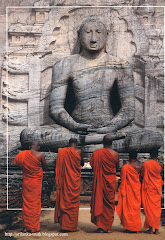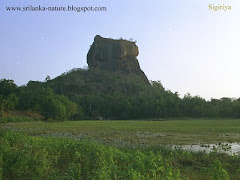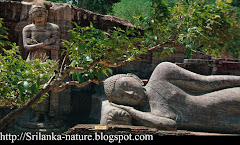Legendary and early history (500 - 250 BC)
The Pali chronicles, i.e., the Dipavamsa, Mahavamsa, Thupavamsa and the Chulavamsa as well as a large collection of stone inscriptions, the Indian Epigraphical records, the Burmese versions of the chronicles etc., provide an exceptional record for the history of Sri Lanka from about the 6th century B.C. The Mahavamsa, written circa 5th century A. D. by the monk Nagasena, using the Deepavamsa, the Attakatha and other written sources available to him, correlates well with the Indian history of the period, with King Asoka's dates of reign actually discovered through the Mahavamsa. The account of the period prior to Asoka's coronation (given in the Mahavamsa as 218 years after the Buddha's death) seems to be part legend. Thus the history begins with the arrival of Vijaya and his 700 followers. Vijaya, is a Kalinga(ancient Orissa) prince, the eldest son of King Sinhabahu (means:-"Man with Lion arms") and Queen Sinhasivali, who were siblings born by a mythical union between a lion and a human princess. The historian contrives the chronology to claim that Vijaya landed on the same day as the death of the Buddha (See Geiger's preface to Mahavamsa), giving added significance to Vijaya's arrival. The story of Vijaya and Kuveni (the local reigning queen) is reminiscent of Greek legend, and may have a common source in Indo-European folk tales. Vijaya landed near Mahathitha (Manthota or Mannar), and, according to the Mahavamsa, named the Island "Thambaparni" ('copper-colored palms), a name which entered into Ptolemy’s map of the ancient world. Tamirabharani is the old name for the second longest river (known as Malwatu Oya in Sinhala and Aruvi Aru in Tamil); it was a main supply route connecting the capital, Anuradhapura to Mahathitha (Mannar), used by Greek ships and Chinese ships travelling on the Silk Route. Mahathitha was an ancient port, inking the Indian coast and the Persian gulf with Sri Lanka, and frequented by seafaring people in pre-Vijayan times.
The present day Sihalese (and even some Tamils) are a mixture of the indegenous people and other groups that came to the island from various parts of India. The Sinhalese recognize the Vijayan Indo-Aryan influence/civilization and Buddism (that was already in existence prior to the arrival of Vijaya), that set them appart from other groups in neighbouring south India. One must take into consideration that Vijaya's subsequent queens were from Madurai, south India.
Feudal Sri Lanka (250 BC-1600 AD)
Anuradhapura dynasty
DEVANAMPIYA TISSA (250-210 BC). A Sinhalese King of Mauriya clan. His links with Emperor Asoka led to the introduction of Buddhism by Mahinda (son of Asoka) in 247? BC. Sangamitta, (sister of Mahinda) brought a Bodhi sapling via Jambukola(Sambiliturei). There is no evidence in the history of King Ashoka about his having had a son by the name of Mahinda (or by any other name) or a daughter by the name of Sangamitta (or by any other name). This king's reign was crucial to Theravada Buddhism, and for Sri Lanka.
ELARA 205-161 BC, a South Indian Tamil invader who ruled "Pihiti Rata", i.e., Sri Lanka north of the mahaweli, after killing King Asela. During Elara's time, KelaniTissa was a sub-king of Maya Rata (south-west) and KavanTissa was a regional sub-king of Ruhuna (South-east). Kavantissa built Tissa Maha Vihara, Dighavapi Tank and many shrines in Seruvila. DUTU GEMUNU (GAMINI) 161-137 BC – Eldest son of King Kavan Tissa, who was a young man 25 years of age, defeated the South Indian Tamil Invader Elara (over 64 years of age) in single combat, described in the Mahavamsa. Dutugamunu is depicted as a Sinhala "Asoka". The Ruwanwelisaya, built by this king is a dagaba of pyramid-like proportions. It was an engineering marvel.
Five Tamil Chiefs: PULAHATHA deposed by BAHIYA, deposed by PANAYAMARA, deposed by PILAYAMARA, murdered by DATHIYA 88 BC – deposed by Valagambahu, ending Tamil rule. VALAGAMBAHU I 89-77 BC – restored the Dutugamunu dynasty. The Mahavihara Theravada -Abhayagiri(pro-Mahayana) doctrinal disputes arose at this time. The Tripitaka was written in Pali at Aluvihara, Matale. CHORA NAGA (Mahanaga) 63-51 BC; poisoned by his consort Anula. Queen Anula 48-44 BC – Widow of Chora Naga and Kuda Tissa, first Queen of Lanka. She had many lovers who were poisoned by her. She was finally killed by: KUTTAKANNA TISSA. VASABHA 67-111 AD – Vallipuram gold plate; he fortified Anuradhapura and built eleven tanks; many edicts. GAJABAHU I 114-136 – invaded the Chola kingdom and brought back captives. He recovered the tooth relic of the Buddha.
MAHASENA 274-301 AD – The Theravada (Maha Vihara) was persecuted and Mahayana surfaced. Later the King returned to the Maha Vihara. Pandu 429 AD - first of seven Pandiyan rulers, ending with Pithya, 455; DHATUSENA 459-477 AD, his uncle, Mahanama wrote the Mahavamsa, he built "Kalaweva". His son KASHYAPA 477-495 AD, built the famous sigiriya rock palace. Some 700 rock graffiti give a glimpse of ancient Sinhala.
Polonnaruwa rule
VIJAYABAHU I 1055-1110 AD, recaptured the whole Island, and established Polonnaruwa as the new capital. King Vijaya Bahu married from the Kalinga (Orissa) Royal Family a second queen, and had a son Vikrama Bahu and a daughter Ratnavali. His sister, Mitta, married a Pandya Prince who had three sons, the eldest being Manabharana. He married Ratnavali. Their son was PARAKRAMA BAHU I 1153-1186 AD – Grandson of Vijaya Bahu I, Prince of Sinhala-Pandyan-Kalinga descent, son of Manabharana and Vijaya Bahu’s sister, Mitta. He was a very powerful king, noted for his engineering, naval power, art, culture, many Sinhala inscriptions, and even a Tamil edict in Uruthota (Kayts). The Chulavamsa was written by Dharmakirthi, updating the Mahavamsa to include Parakramabahu. It was a great age since the epic Anradhapura period.
(source by : Wikipedia)
Find the Truth
Gee
Are you Satisfy about this blog


















No comments:
Post a Comment